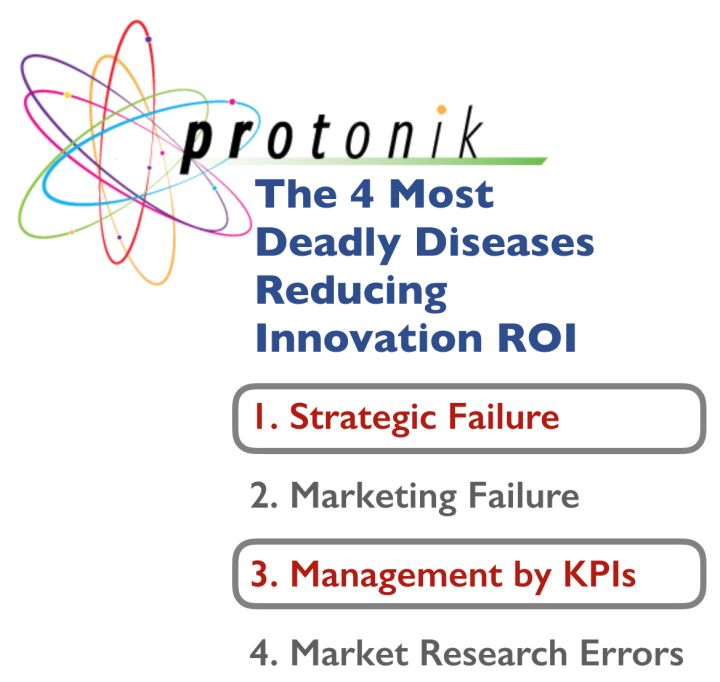
Strategic Failure and Management by KPI: Management Errors Which Kill Innovation (Four Deadly Diseases, Part 2)

“Symptoms…seem to you irrational because you take them in an isolated manner, and you want to interpret them directly.” Jacques Lacan
When corporate managers talk about innovation problems they focus on symptoms — not the more serious underlying diseases. But treating symptoms in isolation won’t cure disease.
My last post introduced the idea of 11 diseases killing innovation of which four are Deadly Diseases. That post looked at marketing problems among the deadliest diseases — issues which are not well considered amidst the vast library of innovation and new product literature.
This post finishes out The Four Deadly Diseases looking at Strategic Failure and Management by KPI.
For a foundation on symptoms I recommend reading the HBR article summarizing recent Innovation Leader/KPMG research about “obstacles to innovation” in large companies.***
Deadly Disease #1: Strategic Failure
Strategic Failure drives nearly every symptom reported by Innovation Leader/KPMG because the impact needed from innovation places it at the center of achieving critical strategic goals. At the same time, strategy needs to be built around each company’s innovation strengths — based on realistic knowledge of the places that innovation can take the company.
Matching innovation and strategy, some companies need a vision of innovative new products or services creating a long term pipeline of market demand. Others may need a vision of how dramatic changes to their internal processes will help drive future demand for products that turns into higher profits. Still others may focus on creating a technological base which creates market advantage AND a barrier to competition.
In fact, the ways innovation and strategy match are endless and each company is unique.
John W. Lewis (@JohnWLewis) is passionate about innovation and strategy and is the current moderator of Twitter’s #Innochat (12 noon Eastern Time every Thursday). So I called John to dig deeper.

As John describes what he typically sees a key error became clear to me: Too many executives and managers believe they should be able to sit in an offsite session and invent the perfect match of strategy and innovation.
John has worked with and around innovation for years. He suggests that only a rare few industries are exceptional with innovation — where each surviving competitor is also equally skilled. These industries have well developed strategies that are formed with, and around, the potential for innovation.
Outside of those industries, the search for strategy and innovation combinations are more frenetic as companies often dash to and fro based on the latest theories. There’s no straight-forward approach which brings order to that situation. And every company/brand/market situation is so different that what one industry or company does can’t successfully be lifted and put down in another industry or company.
Executives in a company without a strong success record with powerful innovation need to start with a period of learning that may require a few years – growing to understand where innovation and strategy should be brought together.
That makes the first strategic step learning – learning what innovation can deliver at the strategic level for the company. In this case, attempting innovations is most crucial. Then, along the way, the company can start developing an understanding of innovation’s role in its strategy.
John observed that as a company learns more, they begin to naturally integrate innovation into strategy and use strategy to guide innovation. Then, over time, they improve their ability to leverage innovation to achieve strategic goals. They also learn where to trust innovation to achieve more aggressive strategic goals.
I’ve also noted that innovation/strategy immaturity leads companies to abandon innovations far to early – often at the first sign of difficulty. As a result there are far too many excellent new products which have been inappropriately put into cold storage. When a company learns their way into innovation strategy, they also learn how to commit and when to stick with innovation to make it succeed.
Defining a successful strategy which leverages innovation won’t happen in a straight-line. As a company proceeds it learns things that change strategy and needs to rewind their process to shift or adjust strategy based on what it learns. This wandering may seem “inefficient” to many companies but it’s not. When confronting a major opportunity, straight lines rarely exist. It’s also been my experience that, counter to general belief, a non-linear approach to innovation is a faster way to achieve big results.

Innovation is not about ideas. John offered that he finds a tendency among executives and senior managers to believe “to be innovative” means “to try lots of ideas”. This isn’t exactly a surprise after 3 decades of strategic consultants telling companies that ideas are strategies. In both cases they are wrong. Ideas are the start of the innovation process – but often not even the most critical part of success with innovation.
This mis-understanding of innovation leads to an odd tension between “we just need a few good ideas” and fear of a mercurial, and therefore uncontrollable, innovation process.
John suggests that executives don’t yet know enough about innovation. “Those who work with innovation all the time know a tremendous amount about about the processes which succeed. We know innovation is not generally an accident and that committed companies can use innovation efforts to reliably create years worth of strategic progress.”
John had a lot more to offer and our discussion dug deeply into innovation challenges. We’re hoping to team to write about strategy in the future.
Strategic failure’s contribution to symptoms.
The HBR article and other write-ups from Innovation Leader show far too many companies innovate only “because they should” — not because they know why they’re doing it. This shows company strategy and innovation entirely disconnected.
Continue down through the list and we find symptoms of strategic failure including alignment problems, politics, lack of budget, lack of the ability to take advantage of opportunity and more. Each and every one of the symptoms are affected deeply when innovation and strategy are not effectively brought together.
Deadly Disease #3: Management by Micro-KPI’s
I hear mumbling already: How can KPIs kill innovation? Aren’t KPIs benign drivers of business improvement as taught in every business program?
Are KPIs are widely taught? Absolutely. Are they benign? Anything but. In fact, KPIs are often a company’s mathematical weapon of self-destruction (to re-write a Cathy O’Neil book title).
 To understand this we need to consider Micro-KPIs vs Macro-KPIs. (The following is a bit long – but in discussions about this post I have come to believe it’s critical understanding about how business execute KPIs today.)
To understand this we need to consider Micro-KPIs vs Macro-KPIs. (The following is a bit long – but in discussions about this post I have come to believe it’s critical understanding about how business execute KPIs today.)
Macro-KPIs are great for managing companies — when kept at a macro level. What I mean by “macro-KPIs” are the important KPIs like profit, cash flow, revenue per employee, etc.. These may sometimes be broken down to divisions or other levels.
Where companies make their KPI mistake is by imposing micro-KPIs at almost every level. Sadly, I find this in almost every company I work with. Let me give a couple of examples of dysfunctional micro-KPIs:
- A buyer in a retail store discovers an innovative new product. For 2 years, they sell that product and get exceptional profits for their department. At the end of 2 years, the product tails off. Their department’s KPI goals, though, are always set as an x% increase over the prior year. While they do fine for two years, in the third year the KPI process automatically creates a goal they’ll never meet. Having had this experience once, they’ll never risk their bonus on an innovative new product again. In the end, that hurts customer interest in coming to the store.
- A photography department at a major sportswear company has KPIs dictated to them based on productivity of each individual photographer. BUT, photographer X shows exceptional impact by advising and supporting the other photographers in their department so that the department’s total output hits goal and the work is better and more effective. However, photographer X is given an ultimatum: hit their goal or leave. The micro-KPI approach sets them up so that if they do what’s right for the company, they will get fired.
I have no problem with close consideration of macro-KPIs in appropriate time periods to evaluate change. They help us ensure good health for the company. I have considerable problem with many micro-KPIs used in corporations today. Perhaps in manufacturing or a finance department they are a superb fit. Not in marketing and not connected to innovation.
As micro-KPIs have become the focus of management in most corporations, the third Deadly Disease has become far worse.
This process has been enabled by computers which make data gathering easy and keep data forever — whether or not the data is worth gathering and keeping. Micro-KPIs also resulted from an MBA curriculum telling students that these goals offer an ironclad way to manage a complex world. (KPIs are, in fact, a complicated response to a complex world. In a complex world, the reductionist assumption of micro-KPIs fail.)
Yet if an innovation is important, we do not know which KPIs are useful nor do we know how to set detailed goals. This is true for any KPIs deeper than the true macro-KPIs. In other words, the KPI impact of any innovation cannot be established in advance.
 I was reading Ben Rich’s book about his time managing Lockheed Skunk Works and the history of the F-117A Stealth Fighter program. Even the most macro-KPIs were nearly impossible to set for a program based on untested, but apparently strong, technology. As manager of Skunk Works, he faced the challenge of how much to ask Lockheed to invest without any way to know what the potential profits would be. It turned out the profits far exceeded early projections — even after testing proved out the technology. Note that THIS is the challenge managing true innovation — there’s quite often no way to know.
I was reading Ben Rich’s book about his time managing Lockheed Skunk Works and the history of the F-117A Stealth Fighter program. Even the most macro-KPIs were nearly impossible to set for a program based on untested, but apparently strong, technology. As manager of Skunk Works, he faced the challenge of how much to ask Lockheed to invest without any way to know what the potential profits would be. It turned out the profits far exceeded early projections — even after testing proved out the technology. Note that THIS is the challenge managing true innovation — there’s quite often no way to know.
Another way to look at this is as a Catch-22: Stability is required for KPI based management. Yet innovation inherently requires living with instability. And even in highly stable situations KPI based management is often more damaging than helpful. Aggressive KPI based management leads employees to create ways to make their numbers stable whether they are or not. And that’s not good for the company.
Sadly, innovation is forced to develop under KPI conditions hostile to it’s mere existence. Management belief in the power of KPIs to control a company has become nearly religious. This should not be the case because KPIs also create tremendous dysfunction — especially with innovative developments.
For example, other people in a company aren’t generally hostile to innovation — employees everywhere want improvement. And in a pre-KPI era, while innovation might make some uncomfortable it could still be readily implemented.
Today, though, KPI goals create major barriers to innovation when they create cross-purposes. Should the employee do what meets their KPIs or do what’s best for the company? (This is a very real problem in many companies.)
Innovation can’t win when employees must choose between their kids’ future (their KPI based bonus) and an innovation that is key to the company future.
I do hope for more discussion on this issue. Executives have spent decades being told that KPIs are the “objective” way to manage people. And newly minted MBAs have spent years being told to adopt the KPI religion.
But before you push back, think deeply about my suggestion that KPIs inherently kill innovation. That mere idea should be shocking and concerning.
The usual response I hear is we need merely be more clever in how we create write KPIs or comp plans. I have never seen that work. Comp plans are incredibly difficult to create in the most stable of situations – and invoke the law of unintended consequences all the time. Fortunately, the truth is that 99% of your employees are dedicated and want to do what works for the company as long as they’re treated fairly in return. The vast majority of employees will deliver outstanding work with or without KPIs.
The Four Deadly Diseases Need to be Managed Together
There’s a tendency in business to use a reductionist approach to problems – reducing big problems to smaller components and solving each separately. This is the hallmark of a complicated approach to business (an error noted by Rick Nason’s writing on the complex in business).
Yet innovation is a complex problem – NOT a complicated one. And applying complicated solutions to complex problems will always end in disaster (although everyone will be busy while getting there).
To overcome these four diseases, companies need to be aware of how the diseases are interconnected and inter-related. Success with strategic goals requires outstanding marketing of any innovative new products your company makes. A focus on internal innovation can only be strategic if it pays out in the market. And market research gives a critical view that should inform all strategy decisions.
Considered together, with a calm search for insight and the ability to recognize and capitalize on discovery, making progress with these can take your company to place you never before thought possible.
Next up: Seven Secondary Diseases looking at problems of mis-management. Click here to read more.
***This research was co-sponsored by KPMG and Innovation Leader and was conducted in 2018. A summary of the Innovation Leader/KPMG research by Scott Kirsner can be found in the Harvard Business Review.
©2019 – Doug Garnett – All Rights Reserved
Through my company Protonik, LLC based in Portland Oregon, I work with clients to drive innovation success with better marketing of new and innovative products and services — work which needs to start before market analysis. I also work with clients attempting to bring new life to Shelf Potatoes or take their existing products to new markets. You can read more about these services and my unusual background (math, aerospace, supercomputers, consumer goods & national TV ads) at www.Protonik.net.
Categories: Big Data and Technology, Business and Strategy, Complexity in Business, Innovation

Posted: February 11, 2019 17:43
7 Secondary Diseases that Kill Innovation: Problems of People, Politics, and Culture | Doug Garnett's Blog
Posted: April 1, 2019 19:11
Marketing Failure & Market Research Error: Two Unspoken Reasons Innovation Fails. (Four Deadly Diseases, Part 1) | Doug Garnett's Blog
Posted: June 4, 2020 04:48
Brain Science: How Process Often Shuts Down Innovative Thinking | Doug Garnett's Blog